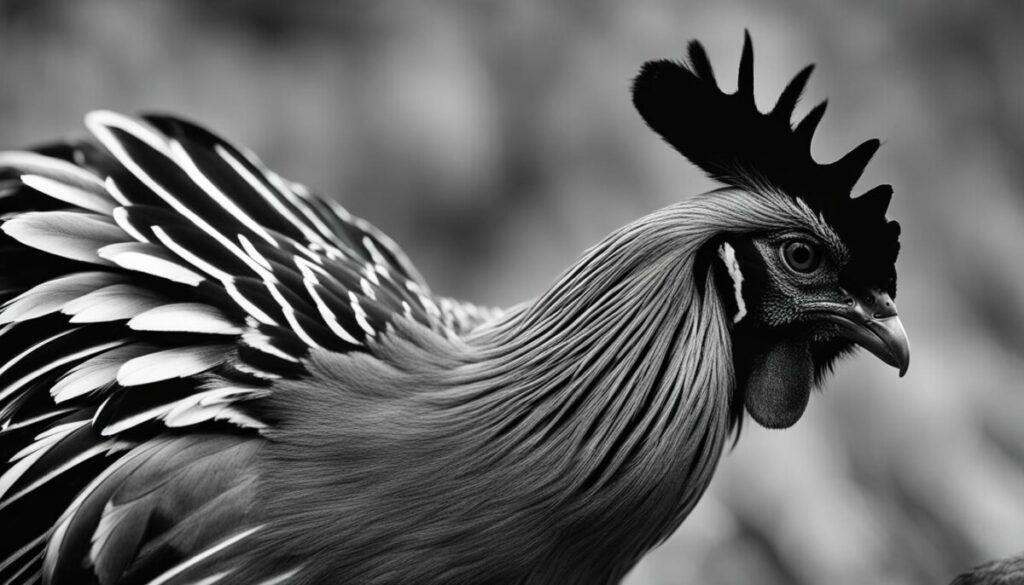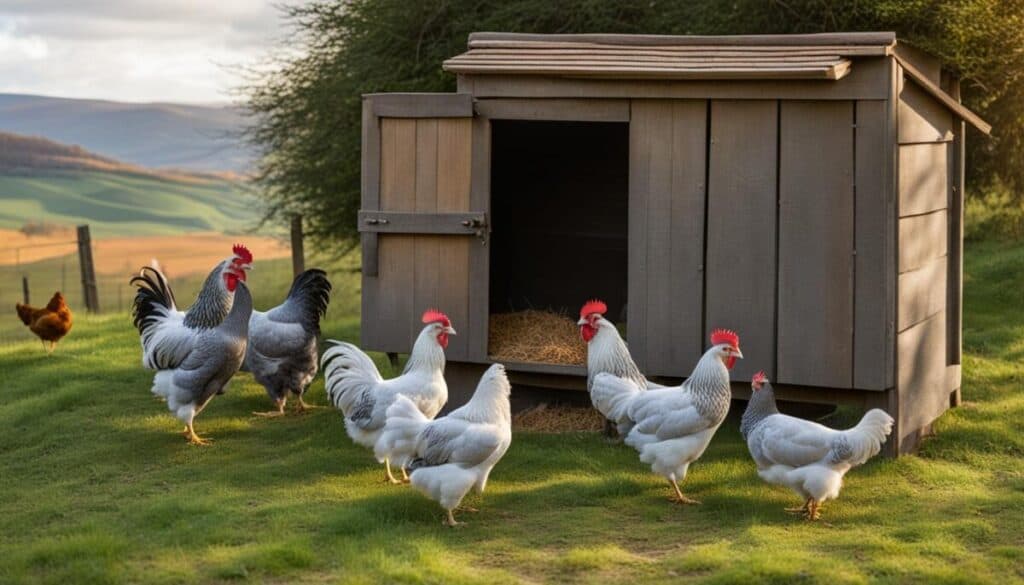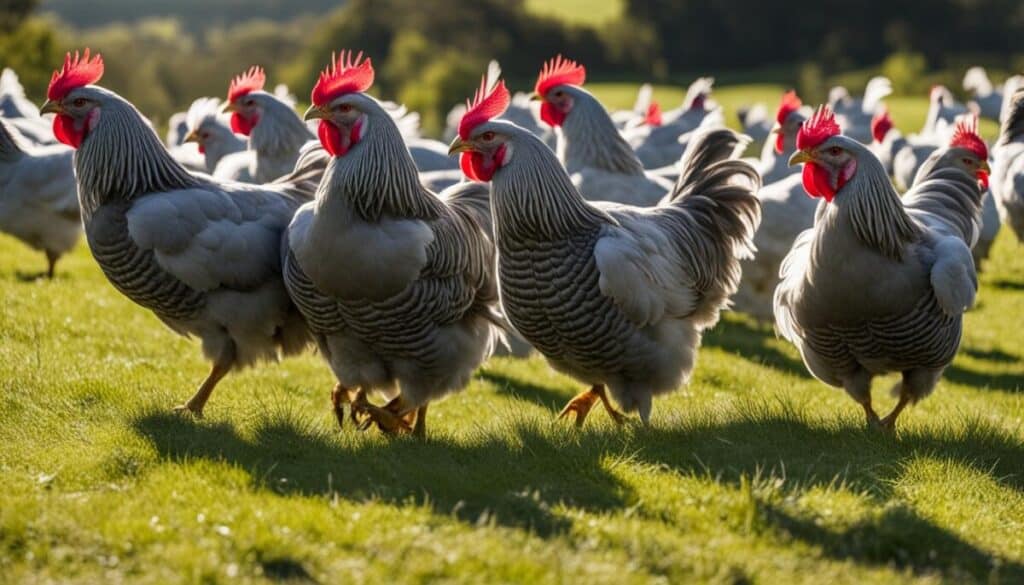Scots Grey chickens are a rare poultry breed that has garnered attention for its historical significance and unique characteristics. As a heritage chicken breed, their preservation has become a priority for conservationists and chicken-enthusiasts alike. In this guide, we’ll explore the origins and evolution of Scots Grey chickens, examine their distinctive characteristics, and provide insights into best practices for caring and breeding this exceptional breed.
Skip AHEAD
- The History of Scots Grey Chickens
- Characteristics and Appearance
- Dual-Purpose Qualities
- Conservation Efforts
- Breeding and Care Considerations
- Availability and Sources
- Living with Scots Grey Chickens
- Scots Grey Chickens in the Show Ring
- Success Stories: Scots Grey Chicken Breeders
- Future Prospects for Scots Grey Chickens
- Conclusion
Key Takeaways
- Scots Grey chickens are a heritage breed with historical significance.
- Conservation efforts are necessary to preserve this rare poultry breed.
- Scots Grey chickens are dual-purpose chickens known for their excellent egg-laying and meat quality.
- Breeders and associations dedicated to heritage poultry breeds can be sources for acquiring Scots Grey chickens.
- Living with Scots Grey chickens requires specific considerations for their temperament and behavior.
The History of Scots Grey Chickens
Scots Grey chickens have a rich history dating back to Scotland in the early 1800s. These birds were primarily used for their meat at the time, with their unique appearance not becoming popular until much later.
Initially known as Scottish Grey fowl, they were favored for their hardiness and adaptability to the Scottish climate. These chickens were often bred for their ability to forage, making them a valuable asset to small farmers who relied on their flocks for sustenance.
As farming practices evolved and modern breeds were developed, Scots Greys began to decline in popularity. The breed was nearly extinct by the 1970s, at which point conservation efforts began to become more widespread.
“The Scots Grey chicken has a fascinating history and plays an important role in the heritage of Scottish farming.”
Today, thanks to the dedication of conservationists, Scots Grey chickens are making a comeback. While still considered a rare breed, they are well-suited for small-scale farming and continue to be appreciated for their unique history and striking appearance.
Characteristics and Appearance
Scots Grey chickens are known for their stunning beautiful plumage. Their feathers display a unique combination of colors, with a slate-blue tone on the body and black-and-white stripes on the neck and tail feathers. This unique pattern sets them apart from other chicken breeds, making them an eye-catching addition to any flock or farm.
Aside from their feathers, Scots Grey chickens have distinctive features that contribute to their overall appearance. They have medium-sized, single combs and wattles, and robust, muscular bodies that reflect their reputation as a dual-purpose breed.

As with any breed, Scots Grey chickens have specific traits that set them apart. They tend to be hardier and more resilient than other breeds, with a reputation for being able to thrive in harsher environments. Additionally, their unique feather pattern can vary from bird to bird, making each individual chicken a work of art in its own right.
Dual-Purpose Qualities
Scots Grey chickens are a dual-purpose breed, excelling in both meat production and egg laying. The breed is widely recognized as one of the best egg producers and can lay up to 230 eggs per year. Their eggs have a rich, creamy flavor and are larger than those produced by other breeds, making them particularly desirable for baking and cooking.
In addition to their egg-laying capabilities, Scots Grey chickens are also good for meat production. They are a slow-growing breed, which results in a higher meat quality compared to faster-growing breeds. Their meat is flavorful and tender, making them a perfect choice for small-scale farming and backyard flocks.
Keep in mind that to maximize their dual-purpose potential, Scots Grey chickens require proper nutrition and living conditions. They should be given a well-balanced diet and enough space to move around comfortably.
Conservation Efforts
The conservation of rare poultry breeds, including Scots Grey chickens, is essential for preserving genetic biodiversity and promoting sustainable agriculture practices. Through conservation efforts, we can ensure that these unique breeds continue to exist for future generations to enjoy.
A number of initiatives and organizations are dedicated to the conservation of heritage chicken breeds, such as the Livestock Conservancy and the Rare Breeds Survival Trust. These groups work to raise awareness about the threats facing rare poultry breeds and promote breeding and conservation programs to protect them.
Conservation efforts can include a range of activities, such as:
- Creating breeding programs to increase the populations of rare breeds.
- Encouraging backyard poultry farmers to raise rare breeds and participate in conservation activities.
- Engaging in outreach and education efforts to raise awareness about the importance of preserving rare poultry breeds.
By supporting these conservation efforts, we can help ensure a sustainable future for Scots Grey chickens and other rare poultry breeds. Together, we can preserve the genetic diversity that is essential for maintaining healthy and resilient poultry populations.

Breeding and Care Considerations
Scots Grey chickens are a resilient and hardy breed that requires specific care and attention to thrive. Here are some key breeding and care considerations:
Housing
Scots Grey chickens are highly adaptable and can be raised in a variety of environments, from free-range to coop living. However, it’s essential to provide a sheltered area that is safe, dry, and offers protection from the elements. Their coops should have good ventilation, be well-insulated, and have enough space to allow for comfortable movement.
Feeding Requirements
Scots Grey chickens have a healthy appetite and will consume a wide variety of food sources, including insects, fruits, vegetables, and grains. It’s important to provide a balanced diet that includes necessary nutrients, as well as access to clean water at all times. Supplementing their diet with oyster shells can promote strong eggshells.
Health Concerns
Like all chickens, Scots Grey chickens are susceptible to a range of health concerns, including parasites, respiratory infections, and egg-laying issues. Regular check-ups, preventative measures, and a clean coop can help prevent and manage health issues. Consulting with a veterinarian who has experience with poultry is also recommended.
General Tips for Raising Scots Grey Chickens
- Be patient when introducing new birds to the flock, and carefully observe any signs of aggression or bullying.
- Regularly check for mites and lice, and use appropriate treatments as needed.
- Provide ample outdoor space for exercise and foraging, as well as opportunities for dust bathing.
- Consider investing in a high-quality feeder and waterer to minimize waste and contamination.
- Offer nesting boxes that are comfortable, private, and secure to encourage egg-laying.
By giving Scots Grey chickens proper care and attention, they can live healthy and happy lives, while also providing a source of high-quality eggs and meat for your family.
Availability and Sources
If you’re interested in adding Scots Grey chickens to your flock, you may face some challenges due to their status as a rare poultry breed. However, there are still several potential sources for acquiring them. One option is to search for breeders who specialize in heritage poultry breeds, such as The Livestock Conservancy’s Breeders Directory.
You may also be able to find Scots Grey chickens at hatcheries that offer rare or specialty breeds. Some hatcheries that carry Scots Greys include Murray McMurray Hatchery and Greenfire Farms.
| Source | Description | Price Range |
|---|---|---|
| Breeder | A private breeder who specializes in heritage poultry breeds. | $20-$50 per chick |
| Hatchery | A commercial hatchery that offers rare or specialty breeds. | $10-$20 per chick |
| Breeding Association | An organization dedicated to the preservation and promotion of a specific poultry breed. | Membership fee varies |
Regardless of where you acquire your Scots Grey chickens, it’s important to ensure that you are purchasing stock from a reputable source. This can help to ensure that your chickens are healthy and genetically diverse, which is important for the long-term sustainability of the breed.

Living with Scots Grey Chickens
Scots Grey chickens are a joy to have around! Their gentle nature and easy-going temperament make them an excellent choice for those seeking a backyard flock or a small-scale farming operation. However, there are a few things to keep in mind when living with these beautiful birds:
- Introducing them to your existing flock: As with any new addition to your flock, it’s important to introduce Scots Grey chickens slowly and cautiously. Place them in a separate pen or coop adjacent to your existing flock before gradually allowing them to integrate. Monitor their behavior closely during this process to ensure that there are no aggressive interactions.
- Handling and socializing: Scots Grey chickens are generally calm and friendly birds, but, like any animal, they require proper handling and socialization. Spend time with your chickens each day, offering treats and talking to them in a calm, reassuring tone. This will help build trust and encourage them to be more sociable.
- Providing proper shelter: Scots Grey chickens are a hardy breed that can handle most climates, but they still require proper shelter to keep them safe and healthy. Ensure that their coop or pen provides adequate protection from the elements, and that they have enough space to move around comfortably.
In short, living with Scots Grey chickens is a highly rewarding experience that requires a little bit of extra care and attention. With the right approach, these beautiful birds will quickly become beloved members of your flock and provide you with years of enjoyment.
Pros and Cons of Keeping Scots Grey Chickens
| Pros | Cons |
|---|---|
| Beautiful plumage | Low availability |
| Hardy and adaptable | Slow growers |
| Dual-purpose breed | Can be flighty |
| Friendly and docile | May require special breeding considerations |
Scots Grey Chickens in the Show Ring
If you’re interested in exhibiting poultry at shows or competitions, Scots Grey chickens are an excellent breed to consider. They are known for their distinctive appearance, hardiness, and dual-purpose qualities that make them stand out among other chicken breeds.
This section will explore the exhibition aspect of Scots Grey chickens, highlighting their potential as show birds and their recognition in poultry shows or competitions. It will discuss breed standards, typical judging criteria, and provide tips for showcasing these chickens at their best.
Breed Standards
According to the American Poultry Association (APA), Scots Grey chickens should have a straight comb, medium or large size, and distinctive plumage. The feathers should be a rich black color with white or grey barring, giving them a striking appearance that sets them apart from other breeds. They should also have a clean and compact body, with strong legs and good overall proportions.
Judging Criteria
When exhibiting Scots Grey chickens, judges will be looking for birds that meet the breed standards and exhibit the best qualities of the breed. Some common judging criteria include:
- Appearance and plumage
- Size and weight
- Temperament and behavior
- Egg production (if applicable)
It’s important to note that each show or competition may have specific guidelines or requirements for exhibiting poultry, so be sure to check with event organizers and review the rules before participating.
Tips for Exhibiting Scots Grey Chickens
If you’re planning to exhibit Scots Grey chickens, consider the following tips to help showcase your birds at their best:
- Start with healthy, well-bred birds that meet the breed standards
- Groom your birds carefully, including washing and trimming feathers as needed
- Practice handling your birds to help keep them calm and comfortable during the event
- Pack your birds carefully for transport and provide them with proper food and water during the trip
By taking these steps, you can help ensure that your Scots Grey chickens are set up for success in the show ring.

“Scots Grey chickens are a joy to exhibit and always draw attention from judges and fellow enthusiasts. Their striking appearance and unique qualities make them a standout breed in the show ring.”
Success Stories: Scots Grey Chicken Breeders
Many passionate breeders have dedicated their time and energy to the conservation and promotion of the Scots Grey chicken breed. Here are a few success stories that showcase the unique experiences of these breeders.
The Robertson Family
The Robertson family, based in Edinburgh, Scotland, has been breeding Scots Grey chickens for generations. They have a deep appreciation for the breed’s history and have taken great care to preserve its unique characteristics. According to the Robertsons, the Scots Grey is a hardy and intelligent bird that is fiercely independent. They have found that this breed is particularly well-suited to free-range living and has an excellent temperament around humans.

“We have been breeding Scots Grey chickens for over eighty years, and it is a pleasure to see the breed recognized for its beauty and heritage. We hope to continue raising these birds for many years to come.”
Jillian Anderson
Jillian Anderson, from Maine, USA, is a passionate advocate for rare poultry breeds, and she has played an instrumental role in highlighting the unique qualities of the Scots Grey chicken. Anderson has found that the breed is an excellent egg layer and produces high-quality meat with a unique flavor. She has also noted that the Scots Grey is a highly intelligent bird that is easy to manage and care for.
| Breed Characteristics | Jillian’s Experience |
|---|---|
| Hardy and resilient | Survives well in cold Maine winters. |
| Dual-purpose qualities | Great egg production and meat quality. |
| Unique flavor | Delicious meat with a rich and full-bodied taste. |
Andrew Mitchell
Andrew Mitchell, a breeder from Yorkshire, UK, has developed a particular interest in the exhibition side of the Scots Grey breed. Mitchell has found that the breed’s striking and distinctive appearance makes it a popular choice among chicken keepers who enjoy showing their birds. He has noted the importance of careful breeding, saying that attention to detail is critical in ensuring that the breed’s unique characteristics are maintained.
“I love the Scots Grey chicken because it is a challenge to breed; it requires patience, dedication, and a keen eye for detail. But when you see one of your birds win first place in a competition, it’s all worth it.”
These are just a few success stories that highlight the unique qualities of the Scots Grey chicken and the passion of breeders dedicated to its preservation.
Future Prospects for Scots Grey Chickens
As a rare poultry breed, Scots Grey chickens face both challenges and opportunities in the future. Continued conservation efforts, including the work of breeders and organizations, are crucial to preserving this unique heritage breed.
Increased recognition could also help to secure the future of Scots Grey chickens. As more people become interested in rare or heritage poultry breeds, Scots Grey chickens may gain popularity and visibility.
However, the breed’s rarity could also be a hindrance. Limited availability and lack of awareness may make it difficult for Scots Grey chickens to become more widely recognized or established in modern agricultural practices.
Regardless of the challenges, Scots Grey chickens will likely remain a cherished and valued poultry breed for those who appreciate their beauty, utility, and historical significance.

Conclusion
As we’ve seen throughout this guide, Scots Grey chickens are a truly unique and important breed for both their historical significance and their valuable dual-purpose qualities. It’s crucial that we continue to support conservation efforts to preserve this rare poultry breed and maintain genetic diversity in poultry populations overall.
Whether you’re looking to add Scots Grey chickens to your backyard flock or simply appreciate their beauty and heritage status, we hope this guide has provided valuable insights into the characteristics, care considerations, and future prospects of these fascinating birds.
Thank you for joining us on this journey and celebrating the wonderful world of Scots Grey chickens!
FAQ
What are Scots Grey chickens?
Scots Grey chickens are a heritage chicken breed originating from Scotland. They are known for their historical significance and distinctive appearance.
What makes Scots Grey chickens a rare poultry breed?
Scots Grey chickens are considered a rare poultry breed due to their limited population and the efforts required to preserve their genetic diversity.
What do Scots Grey chickens look like?
Scots Grey chickens have beautiful plumage, with a mix of grey, black, and white feathers. They have a medium-sized body with a sturdy build and upright posture.
Are Scots Grey chickens good egg producers?
Yes, Scots Grey chickens are known to be good egg producers. They are reliable layers and can produce a steady supply of eggs throughout the year.
Can Scots Grey chickens be used for meat?
While Scots Grey chickens are dual-purpose chickens, they are primarily valued for their egg-laying capabilities. However, their meat is also considered to be of good quality.
How important is the conservation of poultry breeds like Scots Grey chickens?
The conservation of rare and heritage poultry breeds, including Scots Grey chickens, is crucial for maintaining genetic diversity and preserving our agricultural heritage.
What are some care considerations for Scots Grey chickens?
Scots Grey chickens require suitable housing, a balanced diet, regular health checks, and protection from predators. They are generally hardy birds but still need proper care.
Where can I find Scots Grey chickens?
Finding Scots Grey chickens may be challenging due to their rarity. However, you can try contacting breeders, hatcheries, or poultry associations that specialize in heritage chicken breeds.
How do Scots Grey chickens interact with other chickens?
Scots Grey chickens have varying temperaments, but they can generally integrate well with other chicken breeds. Proper introductions and adequate space are essential for successful integration.
Are Scots Grey chickens suitable for exhibition in poultry shows?
Yes, Scots Grey chickens, also known as Scottish Grey fowl, can be shown in poultry exhibitions. They meet breed standards and have the potential to be successful show birds.

